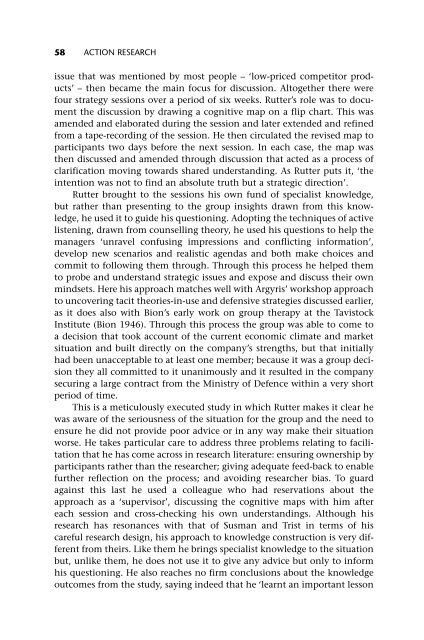Action Research A Methodology for Change and Development
Action Research A Methodology for Change and Development
Action Research A Methodology for Change and Development
You also want an ePaper? Increase the reach of your titles
YUMPU automatically turns print PDFs into web optimized ePapers that Google loves.
58 ACTION RESEARCH<br />
issue that was mentioned by most people – ‘low-priced competitor products’<br />
– then became the main focus <strong>for</strong> discussion. Altogether there were<br />
four strategy sessions over a period of six weeks. Rutter’s role was to document<br />
the discussion by drawing a cognitive map on a flip chart. This was<br />
amended <strong>and</strong> elaborated during the session <strong>and</strong> later extended <strong>and</strong> refined<br />
from a tape-recording of the session. He then circulated the revised map to<br />
participants two days be<strong>for</strong>e the next session. In each case, the map was<br />
then discussed <strong>and</strong> amended through discussion that acted as a process of<br />
clarification moving towards shared underst<strong>and</strong>ing. As Rutter puts it, ‘the<br />
intention was not to find an absolute truth but a strategic direction’.<br />
Rutter brought to the sessions his own fund of specialist knowledge,<br />
but rather than presenting to the group insights drawn from this knowledge,<br />
he used it to guide his questioning. Adopting the techniques of active<br />
listening, drawn from counselling theory, he used his questions to help the<br />
managers ‘unravel confusing impressions <strong>and</strong> conflicting in<strong>for</strong>mation’,<br />
develop new scenarios <strong>and</strong> realistic agendas <strong>and</strong> both make choices <strong>and</strong><br />
commit to following them through. Through this process he helped them<br />
to probe <strong>and</strong> underst<strong>and</strong> strategic issues <strong>and</strong> expose <strong>and</strong> discuss their own<br />
mindsets. Here his approach matches well with Argyris’ workshop approach<br />
to uncovering tacit theories-in-use <strong>and</strong> defensive strategies discussed earlier,<br />
as it does also with Bion’s early work on group therapy at the Tavistock<br />
Institute (Bion 1946). Through this process the group was able to come to<br />
a decision that took account of the current economic climate <strong>and</strong> market<br />
situation <strong>and</strong> built directly on the company’s strengths, but that initially<br />
had been unacceptable to at least one member; because it was a group decision<br />
they all committed to it unanimously <strong>and</strong> it resulted in the company<br />
securing a large contract from the Ministry of Defence within a very short<br />
period of time.<br />
This is a meticulously executed study in which Rutter makes it clear he<br />
was aware of the seriousness of the situation <strong>for</strong> the group <strong>and</strong> the need to<br />
ensure he did not provide poor advice or in any way make their situation<br />
worse. He takes particular care to address three problems relating to facilitation<br />
that he has come across in research literature: ensuring ownership by<br />
participants rather than the researcher; giving adequate feed-back to enable<br />
further reflection on the process; <strong>and</strong> avoiding researcher bias. To guard<br />
against this last he used a colleague who had reservations about the<br />
approach as a ‘supervisor’, discussing the cognitive maps with him after<br />
each session <strong>and</strong> cross-checking his own underst<strong>and</strong>ings. Although his<br />
research has resonances with that of Susman <strong>and</strong> Trist in terms of his<br />
careful research design, his approach to knowledge construction is very different<br />
from theirs. Like them he brings specialist knowledge to the situation<br />
but, unlike them, he does not use it to give any advice but only to in<strong>for</strong>m<br />
his questioning. He also reaches no firm conclusions about the knowledge<br />
outcomes from the study, saying indeed that he ‘learnt an important lesson

















